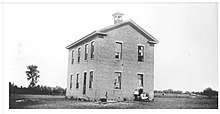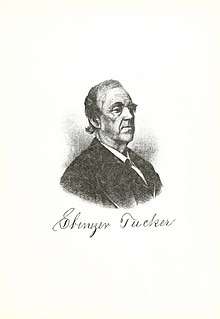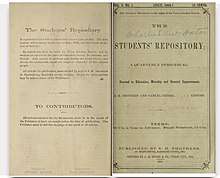Union Literary Institute
The Union Literary Institute, located in rural Randolph County, Indiana, at 8605 East County Road 600 South, Union City, Indiana (at its founding, "two miles east of Spartanburg"), was a school founded in 1846 by abolitionist Quakers and free blacks from Ohio, Kentucky, and North Carolina, after the Indiana Legislature decreed in 1843 that "colored students" could not attend the public schools.[1] When founded it was one of only a handful of American schools in which black and white students studied together; it was the first in Indiana, The school closed briefly because of the Civl War. It published a magazine, and survived until 1880.
| Union Literary Institute | |
|---|---|
 | |
| Location | |
United States | |
| Coordinates | 40°04′38″N 84°48′59″W |
| Information | |
| Type | Racially integrated |
| Established | 1846 |
| Founder | Quakers and others |
| Closed | 1880 |
| Principal | Ebenezer Tucker |
| Faculty | Ebenezer Tucker, Samuel Smothers |
| Campus size | 174 acres (70 ha) |
| Campus type | Agricultural |
| Publication | The Students' Repository |
The school
The first meeting of the Board of Managers, which "uniquely" had both black and white members,[2] was held at the Newtown, Indiana, Society of Friends (Quaker) Meeting House on September 4, 1845.[3] Levi Coffin was on the board.[4]
The school followed the manual labor model, in which students defrayed educational costs through work, in this case farm work. However, it was supported primarily by donations.[5] The term "literary" meant that it was a non-religious school, not that it focused on literature. "Union" has been explained as jointly educating white and black students (quote below); it also is said to refer to the three settlements of free blacks the school was primarily serving: Cabin Creek, Snow Creek, and Greenville, straddling the Ohio–Indiana state line. Randolph County "held the highest percentage of African American residents of any county in Indiana in 1860 (in 1850, it was the 6th highest)", with "a high percentage of anti-slavery whites";[6] the settlements had a steady stream of Underground Railroad fugitives passing through. However, boarding students came from as far as Cincinnati, Indianapolis, and Tennessee.[5] White students also attended, meaning it was one of the very few racially integrated schools in the country.[5]

The curriculum, in 1864, at the "Primary Department", consisted of orthography, reading, writing, "first mental arithmetic", "written arithmetic through fractions", and geography. In the "Higher Department" the subjects were second mental arithmetic, written arithmetic, English grammar, physiology, natural philosophy [science], chemistry, and "first algebra".[7] The first teacher, Rev. Ebenezer Tucker, who was white, was a graduate of the integrated and abolitionist Oneida Institute; he also had a 1844 ministerial degree from anti-slavery Oberlin.[8] He was principal from 1846 through 1854, and after being President of Liber College from 1859 to 1868, returned to Union as teacher and principal from 1873 to 1879.[9]:172–173
The Institution owns one hundred and seventy-four acres of good land, of which more than one hundred are under cultivation. It is located in a flourishing settlement, numbering more than four hundred, and there are other large colored settlements in the region. — There is a boarding house, with accommodations for forty, male and female, and a school house for one hundred scholars. Expenses besides labor, from $20 to $30 per year. The school is conducted on religious (not sectarian) principles. Its Board of Managers belong to five religious denominations. A large number, viz. three hundred colored youth, have received instruction since its establishment, a considerable number of whom have been and are teachers. Perhaps a larger number of colored youth attend this School than any other of the kind in the country. ...Fully three-fourths of the whole number have been persons of color. The Institution has had a hard struggle, but every year adds to its stability and increases its usefulness. Much instruction is here imparted at small expence.... We think well of its plan of "union," bringing colored and white students together, as if indeed the circumstance of color were altogether an accidental and unimportant thing.[10]
Although most students were black, whites also enrolled, making it an early example of racial integration in the Midwest. The black population in the area scattered after the Civil War, and the school in 1880 went out of existence, except for owning title to the property,[11] and the building became a (segregated) school in the local public school system.[5]
The school closed in 1914, and the building was for many years used as a barn. A historical marker at the site was erected in 2016 by the Indiana Historical Bureau and Union Literary Institute Preservation Society:
Union Literary Institute was one of the first schools to offer higher education without regard to color or sex before the Civil War. It was established in 1846 by a biracial board, including free blacks from nearby settlements. At the time, Indiana laws did not allow blacks to attend the public schools. Students labored four hours a day in exchange for room and board. The school was supported by local and national donations, including land. Ebenezer Tucker was the first teacher, and notable attendees included Hiram Revels, the first black U.S. Senator, and James S. Hinton, the first black elected to the Indiana House of Representatives. In 1860 a two-story brick structure was built. The school was a noted Underground Railroad stop.[6]

The Students' Repository
From 1863 until 1864 there appeared six numbers of The Students' Repository: A Quarterly Periodical, Devoted to Education, Morality & General Improvement, "organ of the students and friends of the Union Literary Institute"; 1,000 copies were printed of one issue.[12] It was mentioned in Harper's[13] and received 3 pages in the North American Review.[14] It ceased when the school's one teacher and editor of the publication, Samuel H. Smothers, an African American who had only 9 months of formal education,[15] "volunteered for the Army of the United States".[16] (The school also suspended operations at the same time.[17]) Among the contents:
- "Uncle Abram", a report on an elderly slave whipped severely,[18] by E[lkanah] Beard, "chief field agent in the Mississippi valley for the Freedman's Committee of the Indiana Yearly Meeting of Friends".[19] Beard also contributed "A Trip Down the Mississippi River", on conditions in the contraband camps.[20] Beard's journals were not transcribed and published until 2017.
- A famous contributor was Charles Eliot Norton: "The Moral Unity of the Human Race", described as an "Extract from an Address...on the 'Correspondence of American Principles in Religion and Politics', read before the Autumnal Convention of the Unitarians, at Springfield, Mass., Oct. 14, 1863."[21]
- Also by Norton: "The Legend of the Wandering Jew", along with an "extract from one of his recent letters to us", appeared in the final number.[22]
Notable students
- Hiram Rhodes Revels, the first African-American U.S. senator.
- Amanda Way, president of the Indiana Women's Suffrage movement.
- James Sidney Hinton, the first black elected to the Indiana House of Representatives.
Archival material
The William Henry Smith Memorial Library of the Indiana Historical Society, Indianapolis, owns the Union Literary Institute Recording Secretary's book, 1845–1890.[3]
References
- Beilke, Jayne (2007). "Multicultural Issues". In Cayton, Andrew R. L.; Sisson, Richard; Zacher, Chris (eds.). American Midwest. Indiana University Press. p. 853. ISBN 9780253003492 – via Project MUSE.
- Smothers, Roane; Keiser, Connor. "Free Black Community Participation in the Underground Railroad". Ohio River National Freedom Corridor. Retrieved October 5, 2019.
- Moore, Wilma L. (2010). "Union Literary Institute Recording Secretary's book, 1845–1890" (PDF). Manuscripts and Visual Collections Department, William Henry Smith Memorial Library, Indiana Historical Society.
- Emery, Millicent Martin (December 12, 2016). "Grant will help save Randolph County historic site". Pal-Item.
- "Union Literary Institute". Atlas Obscura. 2019.
- "Union Literary Institute". Indiana Historical Bureau. Retrieved October 5, 2019.
- "Union LIterary Institute". Students' Repository. 2 (2). September 1864. p. 66.
- Triennial Catalogue of Oberlin College 1863. Oberlin. 1863. p. 13 – via Google Books.
- Tucker, Ebenezer (1882). History of Randolph County, Indiana. Chicago: A. L. Kingman.
- "Union Literary Institute". Anti-Slavery Bugle (Lisbon, Ohio). June 18, 1853. p. 2 – via newspapers.com.
- "Legal Fight Over Old Academy Ended; State to Get Property". Indianapolis News. December 12, 1924. p. 49 – via newspapers.com.
- "Miscellaneous". The Student's Repository. 2 (1). July 1, 1864. p. 30.
- "Literary". Harper's Weekly. October 31, 1863. p. 691.
- "The Students' Repository (review)". North American Review. 97 (201). October 1863. pp. 557–559. JSTOR 25100447.
- Smothers, S. H. (October 1863). "Black-board exercises in school". The Students' Repository. 1 (2). pp. 33–34.
- "Notice to Subscribers". The Students' Repository. 2 (2). October 1, 1864. p. Unpaged.
- "Union Literary Institute". 1 (4). April 1864. p. Inside back cover.
- Beard, E[lkanah] (January 1864). "Uncle Abram". The Students' Repository. 1 (3). pp. 82–85.
- Kennedy, Thomas C. (2009). A History of Southland College. University of Arkansas Press. p. 4 – via Project MUSE.
- Beard, E[lkanah] (October 1863). "A Trip Down the Mississippi River". The Students' Repository. 1 (2). pp. 35–36.
- Norton, Charles Eliot (January 1864). "The Moral Unity of the Human Race". The Students' Repository. 1 (3). p. 91.
- Norton, Charles Eliot (October 1, 1864). "Classical Studies; The Legend of the Wandering Jew". The Students' Repository. 2 (2). pp. 47, 49–51.
Further reading
- "Preamble and Constitution of the Union Literary Society [sic] (followed by remarks by the board president and secretary)". The Students' Repository. 1 (1). July 1863. pp. 18–20.
- Union Literary Institute Preservation Society (2010). History of the Union Literary Institute. Ball State University Center for Historic Preservation. OCLC 914233511.
The focus of this booklet is the Union Literary Institute building (ULI) located in Randolph County, Indiana, on County Road E 600 S, east of the crossroad with County Road S 850 E. The information found within this narrative is from the Union Literary Institute Building Preservation Plan that was developed for the Randolph County Commissioners and the Union Literary Institute Preservation Society by the Center for Historic Preservation at Ball State University in 2010.